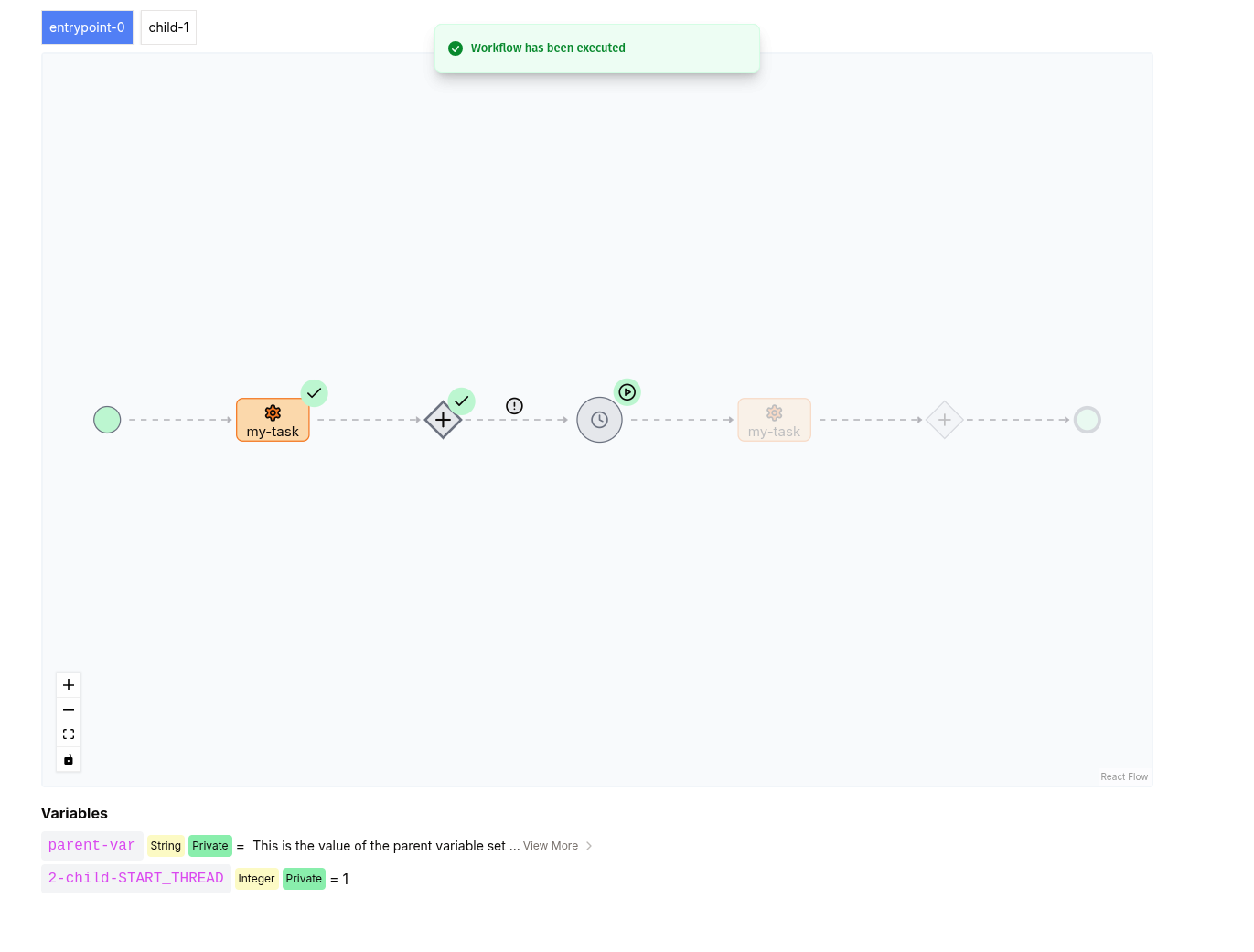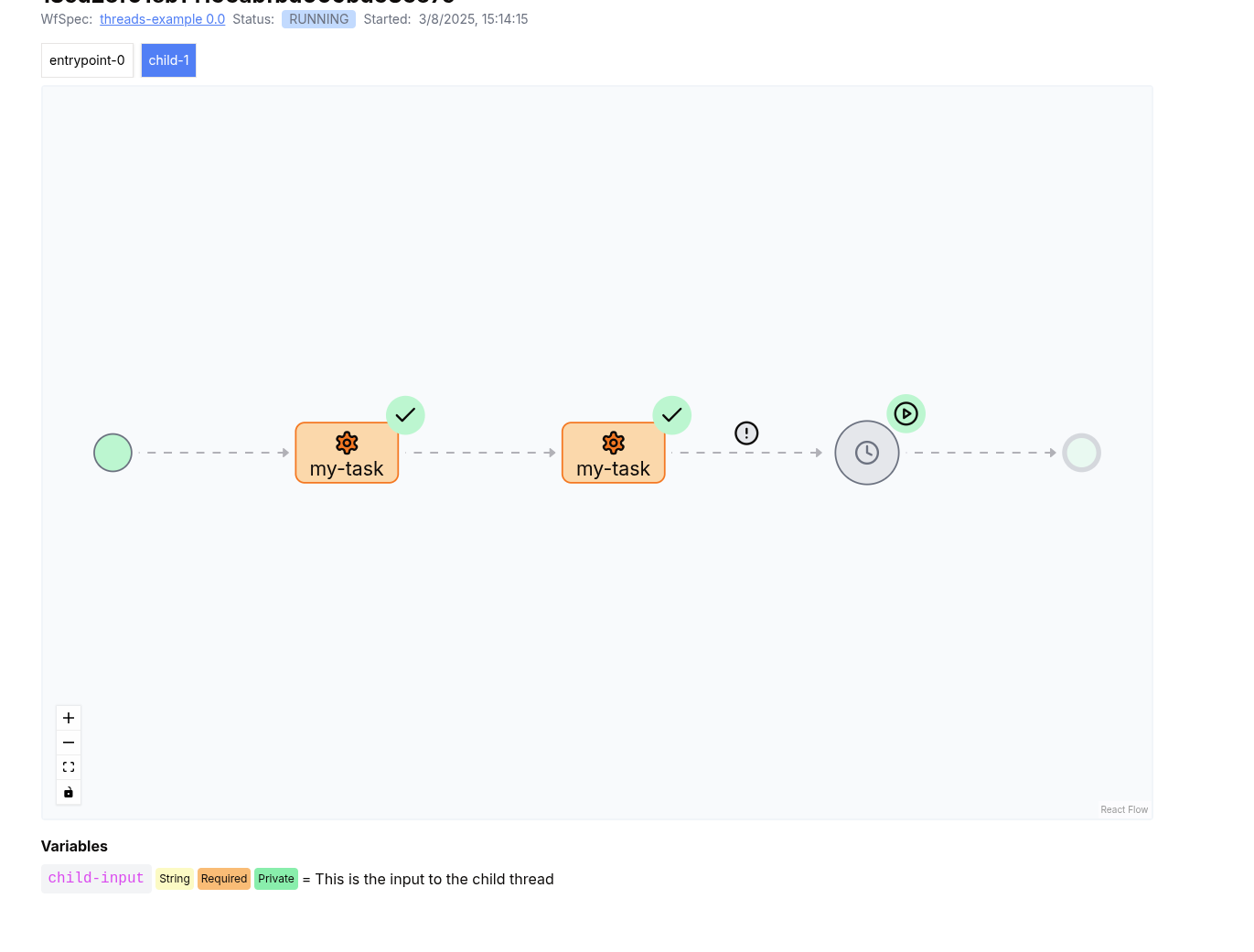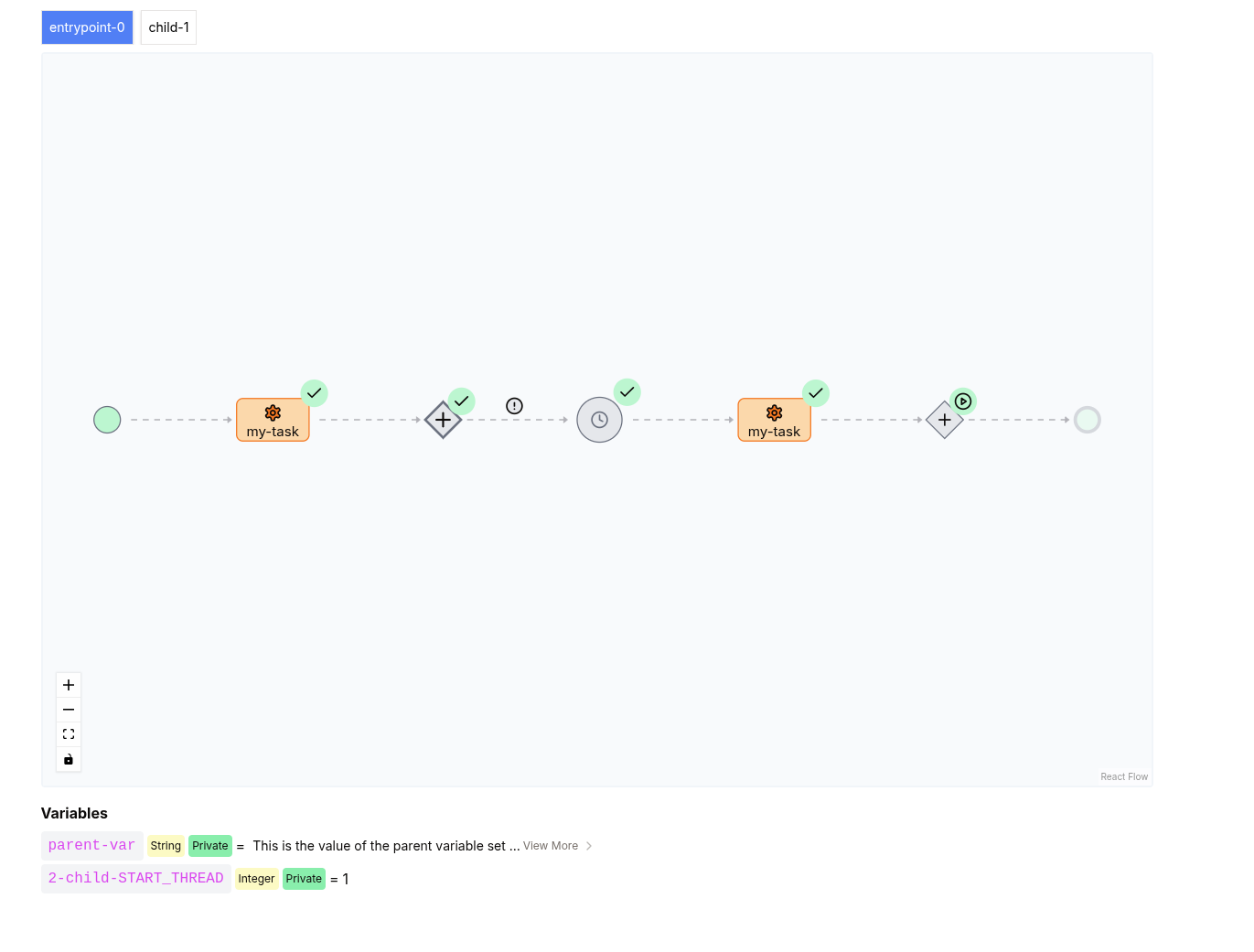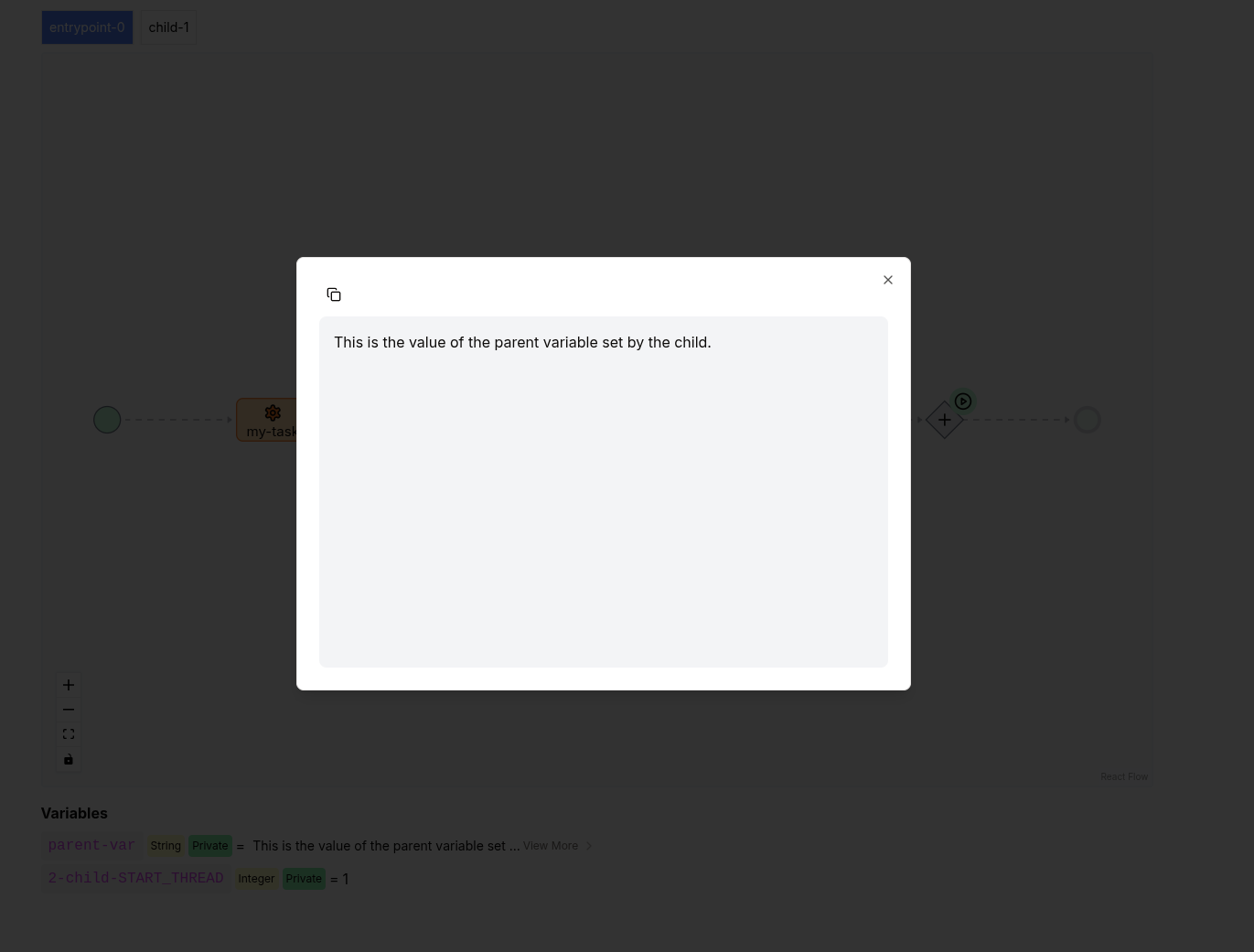Threads
A single program can execute multiple things at once (in parallel) using threads. Likewise, a single WfRun can do multiple things at once using threads.
Concepts
Every NodeRun in LittleHorse is part of a ThreadRun, and every ThreadRun is part of a WfRun. Up until this point in our LittleHorse Concepts series, every WfSpec we have seen has only one ThreadSpec and every WfRun has only one ThreadRun. Using multiple threads in your workflow allows you to execute work in parallel. Some use-cases for threads include:
- Parallelizing computation for performance reasons.
- Executing different business processes in parallel (for example, requesting approval from different departments).
Thread Hierarchy
Every WfSpec has a special ThreadSpec called the Entrypoint thread. When you run a WfRun, you are actually starting the entrypoint ThreadSpec. No matter how many ThreadRuns you have in your WfRun, the status and lifecycle of the WfRun always reflects the status of your entrypoint ThreadRun.
Every ThreadRun in a WfRun except for the Entrypoint ThreadRun has a Parent ThreadRun. Any ThreadRun can create a Child by explicitly starting a child ThreadRun (we will see how to do that very soon). Crucially, every ThreadRun in your WfRun executes in parallel.
Variable Scoping
Previously, we saw how you can declare variables in your WfSpec. What we actually did was declare variables at the entrypoint ThreadSpec level. Every ThreadSpec can declare its own variables.
In LittleHorse, a ThreadRun has the ability to access (both read and write) its own variables and also any variables that its parent has access to (this is recursive all the way up to the Entrypoint ThreadRun). However, a Parent ThreadRun cannot access the variables of its children ThreadRuns.
Waiting for Threads
If a ThreadRun starts a Child ThreadRun, it can deliberately wait for that Child to terminate (either complete or fail). As we will see in the Exception Handling section, any failure thrown by the Child is received by the Parent when the Parent waits for the Child.
If a Parent ThreadRun reaches the EXIT node before all of its Children have terminated, the EXIT NodeRun will remain RUNNING until all Children have terminated. This guarantees that when a ThreadRun is terminated, then all of its children are terminated.
By extension, when an Entrypoint ThreadRun is terminated, we know that all Children of the Entrypoint are terminated, which is why we use the Entrypoint's status as the WfRun's status.
In Practice
In this example, we will define a fictitious WfSpec that illustrates some useful concepts about how threads work in LittleHorse. Our WfSpec's Entrypoint thread will create a Child ThreadRun, sleep a little bit, execute a TaskRun, and then wait for the Child to finish.
In this example, we will show how you can deliberately start a Child ThreadRun in your WfRun. However, Child ThreadRuns can also be created in two other ways as well:
- Through Interrupts
- Through Exception Handling
One potential pitfall when using threads in LittleHorse is a limit to the number of threads that you can put into one WfRun. Since each ThreadRun shows up as part of the WfRun protobuf object (much unlike NodeRuns which have no limits), you don't want to go beyond 100-200 ThreadRuns within a single WfRun.
Building the WfSpec
We will build a demonstration WfSpec that has complex interactions between a parent and child thread. Specifically, the parent and child will both utilize and modify a shared variable (owned by the Parent, of course). We will use the sleepSeconds() utility to make the ThreadRuns wait long enough for us to observe what's going on in the dashboard.
Background: the Task
Our Task Worker will make use of the WorkerContext to print out exactly which ThreadRun is calling it. This will let us look at the Task Worker logs in order to easily see what's going on as we build our mental model of threads in LittleHorse.
- Java
- Python
- Go
- C#
package io.littlehorse.quickstart;
import io.littlehorse.sdk.common.config.LHConfig;
import io.littlehorse.sdk.worker.LHTaskMethod;
import io.littlehorse.sdk.worker.LHTaskWorker;
import io.littlehorse.sdk.worker.WorkerContext;
class MyWorker {
@LHTaskMethod("my-task")
public String myTask(String input, WorkerContext context) {
int threadRunNumber = context.getNodeRunId().getThreadRunNumber();
String threadName = (threadRunNumber == 0 ? "parent" : "child");
String result = "Hello from the " + threadName + " thread: " + input;
System.out.println(result);
return result;
}
}
public class Main {
public static void main(String[] args) throws Exception {
LHConfig config = new LHConfig();
LHTaskWorker worker = new LHTaskWorker(new MyWorker(), "my-task", config);
worker.registerTaskDef();
Runtime.getRuntime().addShutdownHook(new Thread(worker::close));
worker.start();
}
}
import asyncio
import littlehorse
from littlehorse import create_task_def
from littlehorse.config import LHConfig
from littlehorse.worker import LHTaskWorker, WorkerContext
config = LHConfig()
async def my_task(input: str, context: WorkerContext) -> str:
thread_run_number = context.node_run_id.thread_run_number
thread_name = "parent" if (thread_run_number == 0) else "child"
result = f"Hello from the {thread_name} thread: {input}"
print(result)
return result
async def main():
await littlehorse.start(LHTaskWorker(my_task, "my-task", config))
if __name__ == "__main__":
create_task_def(my_task, "my-task", config)
asyncio.run(main())
import (
"github.com/littlehorse-enterprises/littlehorse/sdk-go/littlehorse"
)
func MyTask(input string, context *littlehorse.WorkerContext) string {
threadRunNumber := context.GetNodeRunId().GetThreadRunNumber()
var threadName string
if threadRunNumber == 0 {
threadName = "parent"
} else {
threadName = "child"
}
result := "Hello from the " + threadName + " thread: " + input
return result
}
func main() {
config := littlehorse.NewConfigFromEnv()
worker, _ := littlehorse.NewTaskWorker(config, MyTask, "my-task")
worker.RegisterTaskDef()
worker.Start()
}
using LittleHorse.Sdk;
using LittleHorse.Sdk.Worker;
namespace Quickstart;
class MyWorker
{
[LHTaskMethod("my-task")]
public string MyTask(string input, LHWorkerContext context)
{
int threadRunNumber = context.GetNodeRunId()!.ThreadRunNumber;
string threadName = threadRunNumber == 0 ? "parent" : "child";
string result = "Hello from the " + threadName + " thread: " + input;
Console.WriteLine(result);
return result;
}
}
public class Program
{
static void Main(string[] args)
{
var config = new LHConfig();
LHTaskWorker<MyWorker> worker = new LHTaskWorker<MyWorker>(new MyWorker(), "my-task", config);
worker.RegisterTaskDef();
AppDomain.CurrentDomain.ProcessExit += (sender, e) =>
{
// Close processes gracefully, for each one does a call to the server, and it could be some disconnections.
worker.Close();
};
worker.Start();
}
}
The WfSpec Code
Here's the code for the WfSpec. We'll walk through everything that happens as we run it:
- Java
- Python
- Go
- C#
package io.littlehorse.quickstart;
import io.littlehorse.sdk.common.config.LHConfig;
import io.littlehorse.sdk.common.proto.VariableMutationType;
import io.littlehorse.sdk.wfsdk.SpawnedThread;
import io.littlehorse.sdk.wfsdk.SpawnedThreads;
import io.littlehorse.sdk.wfsdk.WfRunVariable;
import io.littlehorse.sdk.wfsdk.Workflow;
import io.littlehorse.sdk.wfsdk.WorkflowThread;
import java.util.Map;
class MyWorkflow {
public static final String WF_NAME = "threads-example";
// Put this variable here so that it's accessible in the child function.
private WfRunVariable parentVariable;
public void entrypointThreadLogic(WorkflowThread wf) {
parentVariable = wf.declareStr("parent-var").withDefault("This is the parent variable's initial value");
wf.execute("my-task", parentVariable);
// Launch a child thread and then sleep for 25 seconds
SpawnedThread child = wf.spawnThread(
this::childThreadLogic, "child", Map.of("child-input", "This is the input to the child thread"));
// Sleep 25 seconds (this gives time for the child to mutate our variable)
wf.sleepSeconds(25);
wf.execute("my-task", parentVariable);
// wait for the child!
wf.waitForThreads(SpawnedThreads.of(child));
}
public void childThreadLogic(WorkflowThread wf) {
// Child threads can take in input variables too! You must set them when
// starting the child thread in the calll to spawnThread()
WfRunVariable childInput = wf.declareStr("child-input").required();
wf.execute("my-task", childInput);
// Child threads can use the parents' variables
wf.execute("my-task", parentVariable);
// Child threads can also mutate the parents' variables:
wf.mutate(
parentVariable,
VariableMutationType.ASSIGN,
"This is the value of the parent variable set by the child.");
// Child will sleep before finishing
wf.sleepSeconds(45);
}
public Workflow getWorkflowGenerator() {
return Workflow.newWorkflow(WF_NAME, this::entrypointThreadLogic);
}
}
public class Main {
public static void main(String[] args) throws Exception {
LHConfig config = new LHConfig();
MyWorkflow mywf = new MyWorkflow();
mywf.getWorkflowGenerator().registerWfSpec(config.getBlockingStub());
}
}
from littlehorse import create_workflow_spec
from littlehorse.config import LHConfig
from littlehorse.workflow import Workflow, SpawnedThreads, WorkflowThread
class MyWorkflow:
def __init__(self):
self.parent_variable = None
def entrypoint_thread_logic(self, wf: WorkflowThread) -> None:
self.parent_variable = wf.declare_str("parent-var")
self.parent_variable.assign("This is the parent variable's initial value")
wf.execute("my-task", self.parent_variable)
child = wf.spawn_thread(
self.child_thread_logic,
thread_name="child",
input={"child-input": "This is the input to the child thread"}
)
wf.sleep(25)
wf.execute("my-task", self.parent_variable)
wf.wait_for_threads(SpawnedThreads.from_list(*[child]))
def child_thread_logic(self, wf: WorkflowThread) -> None:
child_input = wf.declare_str("child-input").required()
wf.execute("my-task", child_input)
wf.execute("my-task", self.parent_variable)
wf.mutate(self.parent_variable, "ASSIGN", "This is the value of the parent variable set by the child.")
wf.sleep(45)
def get_workflow(self):
return Workflow("threads-example", self.entrypoint_thread_logic)
if **name** == "**main**":
create_workflow_spec(MyWorkflow().get_workflow(), LHConfig())
import (
"context"
"log"
"github.com/littlehorse-enterprises/littlehorse/sdk-go/lhproto"
"github.com/littlehorse-enterprises/littlehorse/sdk-go/littlehorse"
)
// Put this variable here so that it's accessible in the child function
var parentVariable *littlehorse.WfRunVariable
func EntrypointThreadLogic(wf *littlehorse.WorkflowThread) {
parentVariable = wf.DeclareStr("parent-var").WithDefault("This is the default value of the parent variable")
wf.Execute("my-task", parentVariable)
// Launch a child thread and then sleep for 25 seconds
child := wf.SpawnThread(Wflogic, "child", map[string]interface{}{
"child-input": "This is the input to the child thread",
})
// Sleep 25 seconds (this gives time for the child to mutate our variable)
wf.Sleep(25)
wf.Execute("my-task", parentVariable)
// wait for the child!
wf.WaitForThreads(child)
}
func Wflogic(wf *littlehorse.WorkflowThread) {
// Child threads can take in input variables too! You must set them when
// starting the child thread in the call to spawnThread()
childInput := wf.DeclareStr("child-input").Required()
wf.Execute("my-task", childInput)
// Child threads can use the parents' variables
wf.Execute("my-task", parentVariable)
// Child threads can also mutate the parents' variables:
wf.Mutate(parentVariable,
lhproto.VariableMutationType_ASSIGN,
"This is the value of the parent variable set by the child.")
// Child will sleep before finishing
wf.Sleep(45)
}
func main() {
// Get a client
config := littlehorse.NewConfigFromEnv()
client, _ := config.GetGrpcClient()
workflowGenerator := littlehorse.NewWorkflow(EntrypointThreadLogic, "threads-example")
request, err := workflowGenerator.Compile()
if err != nil {
log.Fatal(err)
}
_, err1 := (*client).PutWfSpec(context.Background(), request)
if err1 != nil {
log.Fatal("Failed to register workflow:", err1)
}
}
class MyWorkflow
{
public static string WfName = "threads-example";
// Put this variable here so that it's accessible in the child function.
private WfRunVariable _parentVariable;
public void EntrypointThreadLogic(WorkflowThread wf)
{
_parentVariable = wf.DeclareStr("parent-var").WithDefault("This is the parent variable's initial value");
wf.Execute("my-task", _parentVariable);
// Launch a child thread and then sleep for 25 seconds
SpawnedThread child = wf.SpawnThread(
"child", ChildThreadLogic, new Dictionary<string, object> { {"child-input", "This is the input to the child thread"}});
// Sleep 25 seconds (this gives time for the child to mutate our variable)
wf.SleepSeconds(25);
wf.Execute("my-task", _parentVariable);
// wait for the child!
wf.WaitForThreads(SpawnedThreads.Of(child));
}
public void ChildThreadLogic(WorkflowThread wf)
{
// Child threads can take in input variables too! You must set them when
// starting the child thread in the calll to spawnThread()
WfRunVariable childInput = wf.DeclareStr("child-input").Required();
wf.Execute("my-task", childInput);
// Child threads can use the parents' variables
wf.Execute("my-task", _parentVariable);
// Child threads can also mutate the parents' variables:
wf.Mutate(
_parentVariable,
VariableMutationType.Assign,
"This is the value of the parent variable set by the child.");
// Child will sleep before finishing
wf.SleepSeconds(45);
}
public Workflow GetWorkflowGenerator()
{
return new Workflow(WfName, EntrypointThreadLogic);
}
}
public class Program
{
static void Main(string[] args)
{
var config = new LHConfig();
MyWorkflow mywf = new MyWorkflow();
mywf.GetWorkflowGenerator().RegisterWfSpec(config.GetGrpcClientInstance());
}
}
Running the WfSpec
Open the WfSpec and run it from the dashboard. You won't have to pass any input variables—we've hard-coded it into our WfSpec using default values.
So what happens? First, you'll notice on the top of the page that there are two ThreadRuns that you can look at:

The parent ThreadRun is waiting at a SLEEP node, just after starting the child (that happened on the node that is a diamond with a big + sign).
If you look at the value of the parent-variable below the WfRun diagram, you'll see that the child has already modified it.
If you click on the output of the my-task node, you can clearly see that the value is set to This is the parent variable's initial value.. This is because that TaskRun was executed before the Child was started.
If we click on the child-1 (or if we click on the START_THREADS node), we see the following:

Note that the Child ThreadRun is waiiting on a SLEEP node that will take 45 seconds to mature. The Parent's SLEEP node will take 25 seconds tot mature, which means that the parent will advance to the WAIT_FOR_THREADS node and end up waiting for the child.
If we wait a few seconds longer, we'll notice that the Parent has gotten past the SLEEP node and is waiting for the child:

Finally, you can see that the value of the parent-variable has been modified by the child thread (this is the wf.mutate() call we made from the childThreadLogic method):

Further Resources
Congrats on learning how threads work in LittleHorse!
- Try Spawning Multiple Threads at once with a
spawnThreadForEach()call. - Read about Interrupts.
- Read about Exception Handling.